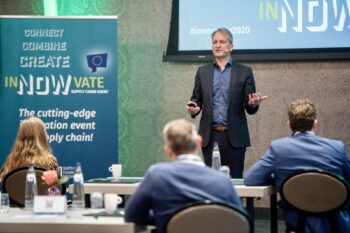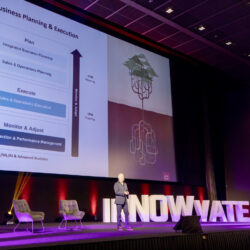Supply chain innovation demands strategic choices

Which technologies should be embraced in order to better respond to disruptions such as the current pandemic? One conclusion from Supply Chain Media’s inNOWvate Supply Chain Event on October 13 is that the answer depends on the strategy deployed. Unilever has consciously opted for an agile supply chain, according to Hemant Badri from the consumer goods company: “Today, we want to be manufacturing the products that we sold yesterday.”
By Marcel te Lindert
There is an urgent need for innovation – and preferably right now. After all, COVID-19 has shown that many supply chains are unable to respond adequately to the consequences of a global pandemic. Innovation can help to prepare those supply chains for the next disruption, but what should you focus on? There are plenty of overviews of technological innovations, such as Gartner’s Hype Cycle and DHL’s Trend Radar, but they don’t tell you how to make a carefully considered choice.
The first step to making choices is to determine the strategy, explained Martijn Lofvers at the start of the inNOWvate Supply Chain Event: “Less than a year ago the economy was flourishing, but now we’re facing major challenges. We have a lot of mountains to climb, but which one will you go for? And which route will you choose to take you to the top? Will it be the shortest, steepest and most difficult route? Or will you choose the easy route that takes longer but still gets you there eventually? That’s called strategy.”
What that strategy looks like depends on several factors: on the level of collaboration both within the company and within the supply chain, on the market conditions and on the competitive situation. “Is the sun shining or is it snowing at the summit? Are your competitors climbing the same mountain or a different one? That affects the choices you make,” said the chief trendwatcher at Supply Chain Media, the organizer of the event that attracted 600 offline and online participants from all over the world.
Trend Compass
 Supply Chain Media has developed a Trend Compass that guides companies in their supply chain innovation activities. Which technologies are most interesting for them depends on their chosen strategy – operational excellence, customer intimacy or product leadership. “A retailer focused on customer intimacy mainly benefits from technologies that enhance the in-store customer experience, whereas technologies that offer customer convenience are a better fit with an operational excellence strategy,” continued Lofvers.
Supply Chain Media has developed a Trend Compass that guides companies in their supply chain innovation activities. Which technologies are most interesting for them depends on their chosen strategy – operational excellence, customer intimacy or product leadership. “A retailer focused on customer intimacy mainly benefits from technologies that enhance the in-store customer experience, whereas technologies that offer customer convenience are a better fit with an operational excellence strategy,” continued Lofvers.
3D printing is a good example. It enables products to be personalized, which is particularly interesting for companies that pursue a customer intimacy strategy. But personalization means extra costs, which is misaligned with a strategy like operational excellence. “3D printing can be interesting for those companies too, but then in the context of producing spare parts, for example.”
Once a company has identified the most interesting technologies, it can look for the innovative businesses that can provide them. “These are the start-ups,” said Lofvers. “We have analysed and categorized 150 supply chain start-ups from across Europe. Four of them will hold a pitch during this event. They have raised more than €500 million in capital between them. Investors don’t part with their money without a good reason! So take a look at these start-ups and discover what they have to offer.”
Concurrent planning
Unilever has already determined its strategy, which is aimed at creating an agile, flexible supply chain. “Today, we want to be manufacturing the products that we sold yesterday. To achieve that, we need a completely different planning approach,” said Hemant Badri, Vice President Worldwide Planning at Unilever.
Badri described how planning traditionally works. Demand planning generates a signal that serves as input for material planning and production planning, which in turn provides input for distribution planning. “Information flows sequentially through the supply chain and the lead times vary from one to four or five weeks. That’s no longer acceptable today. Now, if the demand changes, it must immediately be converted into a signal for production and distribution. If there is a delay in the supply of raw materials, I need to be able to reschedule production immediately and inform customers that we are going to deliver later, or perhaps earlier, than planned.”
Badri talked about concurrent planning, in which every incoming signal is immediately used to synchronize the supply chain. That requires not only an end-to-end planning process but also scenario planning. “What if there’s a sudden rise in demand? Will I still have sufficient production capacity and raw materials? We can use these scenarios to set the right priorities.”
Automated decision-making
 Unilever has embarked on a transformation programme to develop a new end-to-end planning process. Instead of silos that each use their own approach, there will be just a handful of central planning teams that have the best processes and tools at their disposal. Those tools will automatically make the right decisions, taking all the internal constraints and external signals into account. “Our human capacity is limited. We shouldn’t waste it on making the right decisions in every situation. We need to save it for use in crisis situations,” Badri stated.
Unilever has embarked on a transformation programme to develop a new end-to-end planning process. Instead of silos that each use their own approach, there will be just a handful of central planning teams that have the best processes and tools at their disposal. Those tools will automatically make the right decisions, taking all the internal constraints and external signals into account. “Our human capacity is limited. We shouldn’t waste it on making the right decisions in every situation. We need to save it for use in crisis situations,” Badri stated.
Unilever has 3,000 planners. They spend 70% of their time on gathering, validating, interpreting and consolidating data. That leaves 20% for making decisions and 10% for collaborating with other people either within the company or within the supply chain. “That has to change. The 70% is largely spent on repetitive tasks, all of which could be automated. And that includes most of the decisions,” he added.
Cognitive intelligence
Unilever uses planning software from Kinaxis in conjunction with Aera Technology’s cognitive automation technology. “Cognitive intelligence is needed when there’s a deviation somewhere in the chain that the planning software can’t cope with. How would planners react in such a situation? What decisions would they make? We can automate that too,” commented Badri.
The new planning methodology requires not only the right tools, but also the right competencies, which is why Unilever has set up a personal development programme for its 3,000 planners: “Technology supports the new planning process and is necessary to speed up processes. It’s important to provide clarity about the role of technology, but we also need to invest in employee development.”










